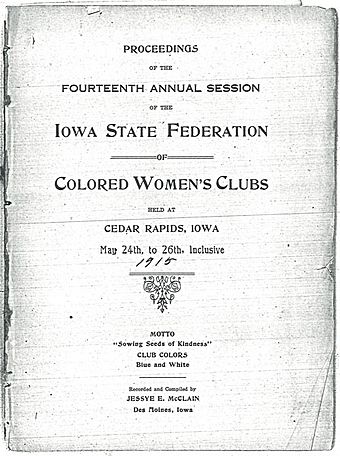Iowa Federation of Colored Women's Clubs facts for kids
Quick facts for kids |
|
|
Iowa Federation Home for Colored Girls
|
|

1915 convention cover
|
|
| Location | 942 Iowa Ave. Iowa City, Iowa |
|---|---|
| Area | less than one acre |
| NRHP reference No. | 82000412 |
| Added to NRHP | December 6, 2019 |
The Iowa Federation of Colored Women's Clubs (IFCWC) was an important group in Iowa. It brought together many clubs for African-American women. Their motto was "Sowing Seeds of Kindness." This organization was connected to the National Association of Colored Women's Clubs.
The IFCWC even published its own magazine called the Iowa Colored Woman. Members from Iowa went to big national meetings. They also attended special events like "Colored Women's Day" at the 1939 New York World's Fair. The IFCWC is also famous for creating a place for black women to live while attending the University of Iowa. This was before the university allowed all students to live together, no matter their race. The building where they lived is now on the National Register of Historic Places.
About the Iowa Federation of Colored Women's Clubs
The IFCWC started in May 1902. At first, it was called the Iowa Association of Colored Women's Clubs. Their first meeting was in Ottumwa. Only a few women and their clubs attended this first gathering. Helen Downey was the first president of the group.
By 1904, about 300 women were coming to the yearly meeting. Clubs from many cities in Iowa sent people to represent them. By 1914, the IFCWC included 40 different African-American women's clubs across Iowa. In that same year, the IFCWC started a committee to support women's suffrage. This meant they worked to help women get the right to vote. Teresa Adams led this important committee.
Iowa Federation Home for Colored Girls
In 1912, Mrs. J.B. Rush, who was the president of the IFCWC, suggested creating a home. This home would be a safe place for black working women to live. In 1919, the IFCWC bought a house at 942 Iowa Avenue in Iowa City. This house later became known as the "Federation Home."
Some white neighbors did not want African Americans to buy the house. They protested and caused the price of the house to be checked again. This made the IFCWC pay more money for the home. In 1934, the home was renamed "Sue Brown Hall." This was to honor Sue M. Wilson Brown, a very important member of the IFCWC.
The home was very important because it gave black women a place to stay while they studied at the University of Iowa. At that time, black students were not allowed to live in the regular university dorms. This rule changed in 1947. The Federation Home closed in 1950. Today, the building is a protected landmark in Iowa City. It was added to the National Register of Historic Places in 2019.
Notable Members



